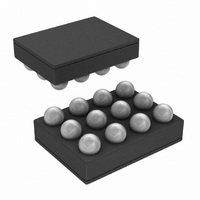LM3530UME-40/NOPB National Semiconductor, LM3530UME-40/NOPB Datasheet - Page 14

LM3530UME-40/NOPB
Manufacturer Part Number
LM3530UME-40/NOPB
Description
IC LED DRVR PROGRAM I2C 12USMD
Manufacturer
National Semiconductor
Series
PowerWise®r
Datasheet
1.LM3530UME-40NOPB.pdf
(44 pages)
Specifications of LM3530UME-40/NOPB
Topology
PWM, Step-Up (Boost)
Number Of Outputs
1
Internal Driver
Yes
Type - Primary
Backlight
Type - Secondary
White LED
Frequency
500kHz
Voltage - Supply
2.7 V ~ 5.5 V
Mounting Type
Surface Mount
Package / Case
12-UFBGA
Operating Temperature
-40°C ~ 85°C
Current - Output / Channel
Adjustable
Led Driver Application
LED Backlighting, Portable Electronics
No. Of Outputs
1
Output Current
29.5mA
Output Voltage
40V
Input Voltage
2.7V To 5.5V
Rohs Compliant
Yes
Lead Free Status / RoHS Status
Lead free / RoHS Compliant
Voltage - Output
-
Other names
LM3530UME-40TR
www.national.com
ALS AVERAGING TIME
The ALS Averaging Time is the time over which the Averager
block collects samples from the A/D converter and then av-
erages them to pass to the discriminator block (see
3). Ambient light sensor samples are averaged and then fur-
ther processed by the discriminator block to provide rejection
of noise and transient signals. The averager is configurable
with 8 different averaging times to provide varying amounts
of noise and transient rejection (see
nator block algorithm has a maximum latency of two averag-
ing cycles; therefore, the averaging time selection determines
the amount of delay that will exist between a steady-state
change in the ambient light conditions and the associated
change of the backlight illumination. For example, the A/D
converter samples the ALS inputs at 16kHz. If the averaging
time is set to 1024ms then the Averager will send the updated
zone information to the discriminator every 1024ms. This
zone information contains the average of 16384 samples
(1024ms × 16kHz). Due to the latency of 2 averaging cycles,
the LED current will not change until there has been a steady-
state change in the ambient light for at least 2 averaging
periods.
Averager Operation
The magnitude and direction (either increasing or decreasing)
of the Averager output is used to determine whether the
LM3530 should change brightness zones. The Averager
block functions as follows:
1.
2.
First, the Averager always begins with a Zone 0 reading
stored at startup. If the main display LEDs are active
before the ALS block is enabled, it is recommended that
the ALS Enable 1 bit is set to '1' at least 3 averaging
periods before the ALS Enable 2 bit is set.
The Averager will always round down to the lower zone
in the event of a non-integer zone average. For example,
FIGURE 4. Ambient Light Input to Backlight Mapping
Table
5). The discrimi-
Figure
14
3.
4.
5.
6.
In the case of two consecutive increases or decreases in the
Averager output, the LM3530 will transition to zone equal to
the last averager output
Using the diagram for the ALS block
information is shown in
input into the A/D, into the Averager, and then into the Dis-
criminator. Each state filters the previous output to help pre-
vent unwanted zone to zone transitions.
When using the ALS averaging function, it is important to re-
member that the averaging cycle is free running and is not
synchronized with changing ambient lighting conditions. Due
to the nature of the averager round down, an increase in
brightness can take between 2 and 3 averaging cycles to
change zones, while a decrease in brightness can take be-
tween 1 and 2 averaging cycles. See
possible Averager periods.
how the perceived brightness change time can vary.
if during an averaging period the ALS input transitions
between zone's 1 and 2 resulting in an averager output
of 1.75, then the averager output will round down to 1
(see
The two most current averaging samples are used to
make zone change decisions.
To make a zone change, data from three averaging
cycles are needed. (Starting Value, First Transition,
Second Transition or Rest).
To Increase the brightness zone, the Averager output
must have increased for at least 2 averaging periods or
increased and remained at the new level for at least two
averaging periods ('+' to '+' or '+' to 'Rest' in
To decrease the brightness zone, the Averager output
must have decreased for at least 2 averaging periods or
decreased and remained at the new level for at least two
averaging periods ('-' to '-' or '-' to 'Rest' in
Figure
5).
(Figure
(Figure
Figure 8
6).
7). This starts with the ALS
shows an example of
(Figure
Table 6
3), the flow of
Figure
Figure
for a list of
6).
30086608
6).











